Since the dawn of agriculture, plants have been plagued by ravenous insect pests. But no gardener wants grasshoppers in his garden, and no farmer wants to see the season’s crops eaten by locusts. How do you get rid of grasshoppers and locusts?
How to get rid of grasshoppers and locusts? To get rid of grasshoppers and locusts, use effective and safe remedies that won’t damage your greenery, including applying neem oil or pepper spray around your yard. You can also use chemical pesticides or hire a pest control specialist in cases of large infestations.
If you want to learn how to get rid of grasshoppers and locusts, we are here to teach you. This article will also cover the differences between locusts and grasshoppers and how to keep grasshoppers and locusts out of your home and yard.
Locust vs. Grasshopper
It can be hard to tell the difference between locusts and grasshoppers. Locusts and grasshoppers look very much alike. Both locusts and grasshoppers have strong hind legs for jumping and strong mouthparts for chewing leaves. And most of the time, locusts and grasshoppers behave very similarly.
Difference Between Locust and Grasshopper
Grasshoppers do not come together in swarms like locusts that darken skies and strip fields and forests. Outside of the mating season, grasshoppers are solitary insects that will avoid each other if given a chance.
Do Grasshoppers Turn Into Locusts?
Most grasshoppers do not form swarms. You might see many more grasshoppers than usual in a season. But those grasshoppers do not fly in unison like a locust swarm. There are a few species of grasshoppers that will, under certain conditions, seek each other out and swarm in search of new food. These grasshoppers are called “locusts.”
Grasshoppers
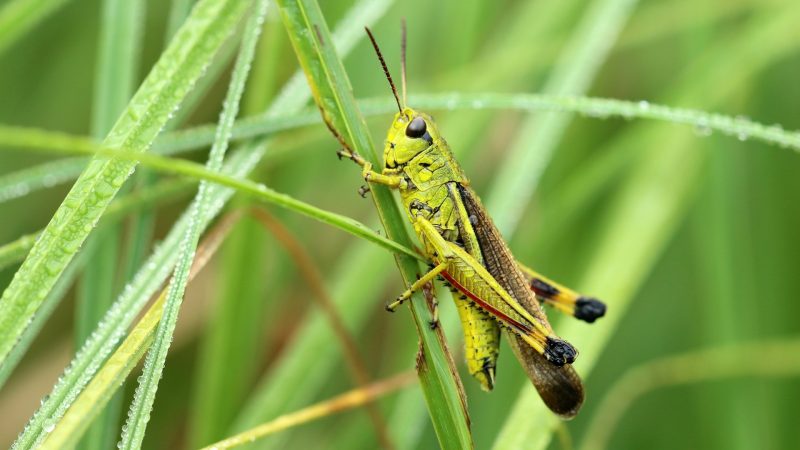
You are far more likely to see a grasshopper than a locust. Locust swarms are an uncommon occurrence – and thankfully so! Here are some helpful facts about grasshoppers.
What Is Grasshopper?
Grasshoppers are some of the most ancient animals. Fossilized ancestors of today’s grasshoppers date back to the Triassic Era. Both locusts and grasshoppers belong to the order Orthoptera and its suborder Caelifera and are closely related to katydids and crickets.
Do Grasshoppers Fly?
When grasshoppers feel threatened, they use their powerful hind legs to hop away from the situation. But grasshoppers have wings and can take to the air in search of food and mates. They don’t travel as far as a locust swarm, but grasshoppers are strong flyers.
How Long Do Grasshoppers Live?
Grasshopper nymphs are born in the springtime and become adults by summer. A grasshopper’s life span is around one year, but they spend most of that time in an egg pod. After hatching, grasshoppers will only live until the first frost.
How Many Legs Does a Grasshopper Have?
Grasshoppers have four short legs and two long legs. They use their long legs for jumping. By rubbing the serrated edges of their legs against their body, they produce a distinctive chirping noise to attract mates.
What Does a Grasshopper Look Like?
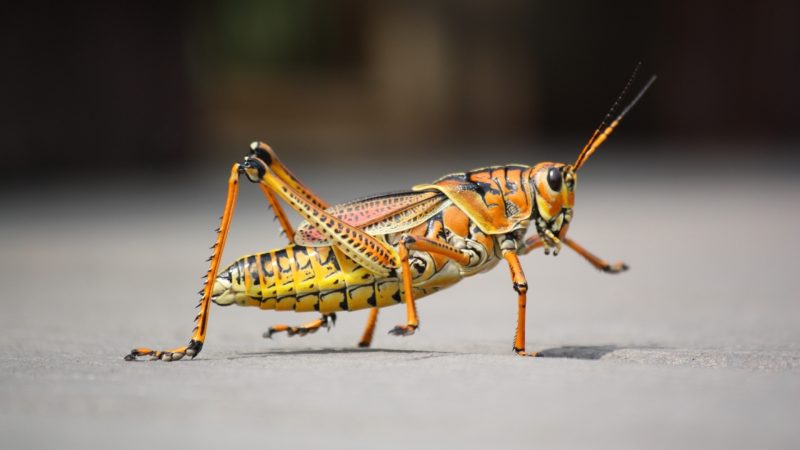
Grasshoppers have green, brown, or black bodies with large hind legs and enormous eyes. Some have red, yellow, or orange markings. Grasshoppers have a large pair of rear wings and long slender forewings. Adult grasshoppers range in size from 1-7 cm (½ to nearly four inches).
Grasshopper Life Cycle
Grasshopper nymphs hatch from their egg pods in the springtime. When you see little green grasshoppers in gardens, you see the next generation of grasshoppers.
Over the next few weeks, the grasshopper nymphs will molt five times until they become adult grasshoppers. Not long after, they will mate. The female lays eggs in sand or under leaf litter, then covers them with a sticky substance that hardens into a pod. In spring, the cycle repeats.
Where Do Grasshoppers Live?
Grasshoppers live on every continent except Antarctica. Scientists have identified over 8,000 species, and there are likely many more grasshoppers that have not yet been classified.
What Do Grasshoppers Eat?
Grasshoppers are herbivores who will eat any part of the plant they can chew. Leaves, stems, flowers, fruit – it’s all lunch to a hungry grasshopper. When they need extra protein, grasshoppers will sometimes snack on an insect corpse.
What Attracts Grasshoppers to Gardens?
Gardens are extremely enticing to grasshoppers when it has tasty crops, good hiding spots and only a few predators.
Although grasshoppers can consume a variety of plant materials, they are particularly drawn to alfalfa, corn, clover, grasses, and tiny grains. Dense planting of any of these crops may draw colonies of grasshoppers to your yard.
Furthermore, grasshoppers favor regions with a lot of weeds and plants since these environments offer more food options, areas to hide from predators, and sites for laying eggs. When there are fewer natural predators present, such as birds and spiders, grasshopper populations will inevitably increase.
Grasshopper’s Impact on Gardens
There is no need to be alarmed if there are a few grasshoppers in your garden. When they leave feces that is full of nourishment for the nearby plants, they can be helpful insects that play a significant part in the environment by feeding predators like birds and lizards.
A vegetable garden can be completely destroyed by a grasshopper infestation, though. Adults have the capacity to ingest up to sixteen times their body weight each day, which causes them to swallow the majority of the leaves while also rendering any surviving plants unable to survive. Your garden plants may be infested with grasshoppers if you notice numerous filthy, nibbled holes in the leaves, stems, fruits, or vegetables of the plants.
Locusts
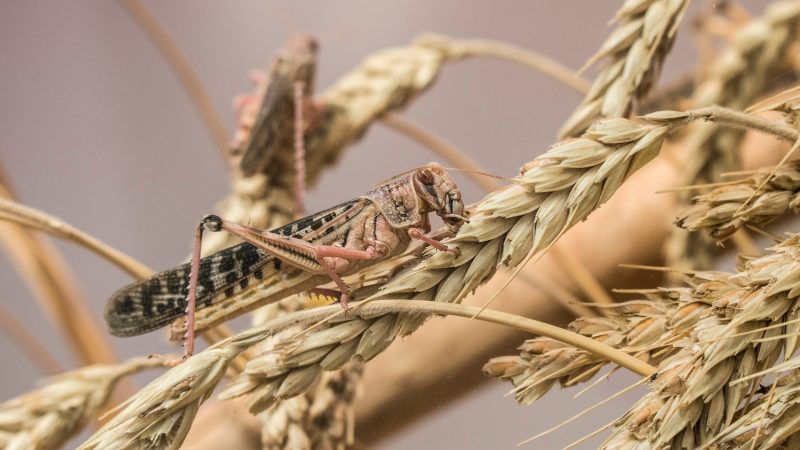
When your garden is getting nibbled to death by grasshoppers, you can’t help but think of the Biblical plague of locusts. And you realize things could be much worse. These grasshoppers may be chewing up your lettuce, but they’re not stripping your crops bare.
So what is the difference between a grasshopper and a locust?
What Is a Locust?
Most of the time, they are difficult to distinguish from other grasshopper species. They mate, eat, and live as solitary insects. But when they are crowded together with diminishing food, locusts form their notorious swarms. Locusts are a species of grasshopper that will swarm under certain conditions. The vast majority of grasshopper species will never swarm.
How Long Do Locusts Live?
Locusts only live for three to six months. But in one generation, under favorable conditions, their numbers can increase 16-fold.
What Does a Locust Look Like?
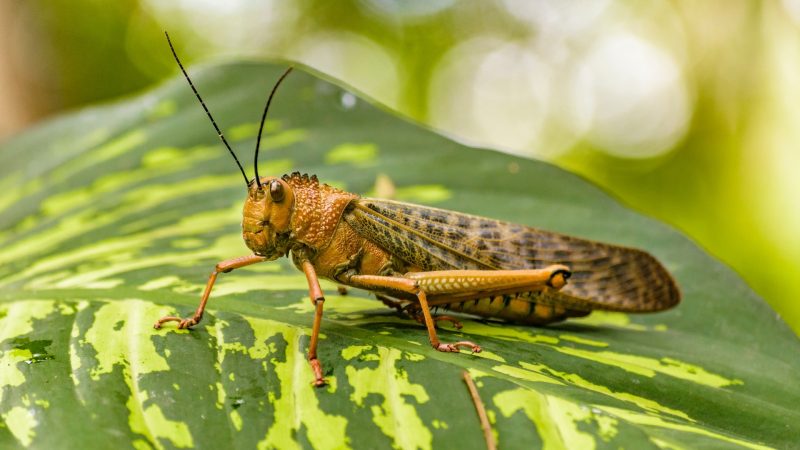
Most of the time, locusts look and behave like any other grasshopper. Until recently, scientists thought solitary locusts – locusts who were not swarming -were a different species than the larger, more brightly colored swarming locusts.
When locusts swarm, their color changes, and their muscles grow larger, allowing them to fly for long distances. Swarming behavior happens through a flood of serotonin in the locusts’ brains, making solitary locusts behave like a unified group.
Locust Life Cycle
Locusts live in barren regions where food is scarce. When the rains come, their home is suddenly full of greenery. During these good times, the locusts come together and breed. Soon the rains end, and food becomes scarce again.
As the locusts get pushed into ever-smaller patches of vegetation, they are forced into close contact with each other. Instead of flying off on their own, they come together like a school of fish. As they eat the last of their food, the hungry locust swarm takes off for greener pastures.
Where Do Locusts Live?
Locusts are usually found in a band stretching across sub-Saharan Africa south of the Sahara and into India. When they swarm, they can reach as far as Europe. Different species of swarming locusts live in Australia and South America.
What Do Locusts Eat?
A locust can eat its weight in vegetation every day. 2 grams might not seem like a lot. But a massive locust swarm can cover 100 square miles or more, with 40 million to 80 million locusts packed in half a square mile. That 100-square-mile swarm can consume as much food in one day as 8.75 million people!
Locust’s Impact on Gardens
Locusts are infamous for the destruction they cause while feeding. They have insatiable appetites and powerful chewing mouth parts.
Locusts are a common result of overcrowding or a shortage of food, and they can inflict unmanageable damage due to their excellent flying abilities. Many farmers have experienced a sense of powerlessness as they saw the massive locust swarms falling upon their fields of crops.
In an instant, locusts will occasionally devour entire plants, while other times they ravage at by chance. While big migratory locusts are challenging to halt, preventive measures can be done to reduce damage.
How To Get Rid of Grasshoppers?
Now that we know more about grasshoppers and locusts, we can deal with the most critical question: What is the best way to get rid of grasshoppers?
How To Get Rid of Grasshoppers in Garden?
Neem oil is a natural way to get rid of grasshoppers on plants. Mix half a teaspoon of neem oil like the Dyna-Gro NEM-008 Neem Oil with half a teaspoon of castile soap in four cups of water. When sprayed on plants, Neem oil is an organic insecticide for grasshoppers and other insect pests.
- Used on any plant to produce clean and shiny leaves
- Natural shine on leaves without clogging the stomata
- Cold pressed from the seeds of the neem tree
- Size: 8 oz
- Available in a variety of sizes
You can also use diatomaceous earth, which scratches an insect’s exoskeleton, causing it it to become dehydrated and die. To use diatomaceous earth as a pesticide, spray it on your plants and your yard. The HARRIS Diatomaceous Earth Food Grade should get your garden through several grasshopper seasons.
- Natural Product - Composed of 10lbs of 100% ground freshwater...
- OMRI Listed - Listed with the Organic Minerals Research...
- Powder Duster Included - Powder duster in the bag for easy and...
- Made in the USA – Mined in Nevada and packaged in Georgia
- Supports a Great Cause - Harris donates 10% of profits to support...
How To Get Rid of Grasshoppers in House?
You can get rid of grasshoppers in your home with a molasses trap. Pour three tablespoons of molasses into a cup of water, then leave this in a waterproof dish or bowl. (Adding a teaspoon of cooking oil will help discourage bees and flies from landing in the mixture).
When the grasshopper smells the sweet molasses, it will jump into the bowl, and then drown as it becomes stuck in the liquid.
How to Get Rid Of Grasshoppers Naturally?
1. Neem Oil
Three tablespoons of neem oil should be added together with two quarts of warm water and a half-teaspoon of liquid dish soap. Grasshoppers’ growth will be slowed and even stunted by applying this mixture over plants.
2. Garlic Spray
Strong aromas like garlic, which might deter grasshoppers from entering your plants, are particularly effective at attracting their attention.
To get rid of grasshoppers, try this garlic/red pepper spray:
- Add four minced cloves of garlic and four chopped cayenne peppers to 6 cups of water.
- Simmer for 20 minutes on medium heat, then let the mixture cool overnight.
- Strain the hot pepper/garlic concentrate.
- Put one cup of this concentrate in a gallon of water, then spray it on your foliage.
You may wish to mist a test area on your plants first to ensure they are not sensitive to the mix. You will also need to reapply after every rain.
3. Diatomaceous Earth
Insects are dried out by this substance, which cuts their bodies and absorbs moisture that escapes. Diatomaceous earth is frequently used to treat common houseplant pests, but it can also serve as an excellent first line of defense in your outdoor garden.
4. Pesticide Soaps
- Protect Plants from Insects - Kills a variety of soft-bodied...
- Gentle on Most Plants - Ideal for use on flowers, herbs...
- Kills On Contact - Potassium salts of fatty acids weaken insects'...
- Use Throughout the Season - Spray plants at the first sign of...
- Peace of Mind – This spray is OMRI Listed and compliant for use...
- KILLS BUGS THROUGH CONTACT: Controls aphids, mealybugs, mites,...
- INSECTICIDAL SOAP: Contains specially selected soaps (fatty acid...
- FOR USE INDOORS, OUTDOORS AND IN GREENHOUSES: Spray on...
- READY-TO-USE SPRAY: Thoroughly spray insect pests on all plant...
- FOR ORGANIC GARDENING: This product can be used in organic homes...
- Targets and kills aphids, earwigs, grasshoppers, harlequin bugs,...
- Also kills plant bugs, psyllids, sawfly larvae, soft scales,...
- OMRI Listed and compliant for use in organic gardening; Does not...
- No residual impact on the environment
- Excellent for use in hydroponic and indoor gardening
A grasshopper-targeted pesticide soap can assist in quickly killing these pests without endangering your plants or produce. For optimal results, mist your plants with the soap at least once every two weeks.
5. Encourage Natural Predators
Several types of wildlife serve as grasshopper’s natural predators and frequently do not harm your garden. The majority of insect-eating fauna, including birds, tiny snakes, toads, and lizards, can aid in reducing or eliminating grasshoppers and halt the spread of infestations.
6. Set Up Natural Traps
The grasshoppers that scurry around your garden can be caught and killed using bait traps. The simplest natural trap is a molasses trap, which is 90% water and 10% molasses.
Because of its density and delicious scent, the mixture will draw grasshoppers and catch them, drowned them in the water. For maximum effectiveness, employing natural traps in addition to other management methods is recommended.
7. All-purpose Flour
A basic household item called all-purpose flour has amazing anti-grasshopper properties. Flour prevents insects from eating by sticking to their mouths, saving your plants and getting rid of pesky grasshoppers from your garden.
How to Prevent Grasshoppers in Your Garden?
Grasshoppers can be kept from gathering in large numbers in a few different ways:
- Numerous other insects including grasshoppers are repelled by specific strong odors. DIY hot pepper, vinegar, and garlic spray are popular home cures for gardeners. Spray the mixture on the yard after placing it in a spray bottle.
- To protect your garden from grasshopper damage, use plastic roofing to put up a wall between the insects and your delicate plants.
- Follow a schedule for pruning. They have fewer places to hide if you keep your garden free of weeds and prune the areas around it.
How To Get Rid of Locusts?
We have been trying to get rid of locusts for thousands of years. So far, we have not succeeded. Locusts ate crops in ancient Egypt and continue to eat crops today. However scientists have not stopped fighting the locust problem.
How To Get Rid of Locusts in Your Garden?
When faced with a locust swarm, governments typically respond with highly toxic pesticides like Malathion, Chlorpyrifos, and Deltamethrin. These are effective at killing locusts, but they also pose severe risks to other local fauna and humans living in the area.
How To Get Rid of Locusts in Home?
If you can’t beat them, eat them. Locusts are an ancient source of protein and a staple part of many diets in the developing world. But rising use of pesticides and chemical fertilizers means that locusts are no longer a safe replacement for the food they consume.
How To Get Rid of Locusts Naturally?
Scientists fighting locusts in Africa have explored using Nosema locustae, a single-celled parasite that kills locusts and grasshoppers. They have also considered importing an Australian wasp whose larvae eat grasshopper egg pods to keep locust populations down. So far, these methods have not stopped locust swarms, though they have become less common occurrences.
You can try the following method for naturally get rid of them.
1. All-Purpose Flour
Dusting surfaces with all-purpose flour, which transforms into dough when digested, can keep locusts alive and unable to eat. Although it is completely safe to use on plants, if it rains shortly after usage, it may get messy.
2. Natural Enemies
Numerous animals, including birds, frogs, lizards, and toads, are predators of grasshoppers. Even helpful insects can take advantage of your hopper concern, such as parasitic wasps.
3. Raise Your Own Chickens or Guinea Fowls
Chickens and guinea pigs perform an excellent job of eating grasshoppers and other common garden pests, however clearly this is unlikely to work for everyone.
Other typical backyard pests like ants and cockroaches can also be managed with the aid of these birds. Insects are an excellent provider of food for these household birds since they are a significant supply of protein, provided they haven’t been subjected to hazardous pesticides.
4. Natural Remedies
There are many natural remedies available if you are not interested in to use chemicals. The best are probably neem soil soaks, which can shield even trees for a maximum of three weeks each dosage. And just 24 hours after treating field crops, you can harvest them.
5. Garlic Tea
Strong repellents like garlic can even instantly kill some pests. Garlic tea is among the simplest and most effective ways to make garlic sprays out of all the options. Simply combine two garlic cloves with 10 cups of water in a blender. The liquid is brought to a boil, then allowed to soak all night
6. Sticky Traps
- 🦟〖Yellow Sticky Traps〗-- Bright yellow color attract...
- 🦟〖Safe and Non-toxic〗-- Gnat killer traps use bright...
- 🦟〖Easy to Use〗-- Easy to peel it and insert it in the...
- 🦟〖Long Lasting〗-- Yellow sticky fruit fly traps with a...
- 🦟〖Package Included〗-- Pack of 36 pcs. 18 Butterflies Shape...
- 🕷️【EFFECTIVE & STICKY TRAP】Our glue traps consist of a...
- 🐞【 FOLDABLE DESIGN & PET-FRIENDLY】 The versatile design of...
- 🪳【PRE-BAITED & NON-TOXIC】The sticky glue traps for insects...
- 🦂【EASY TO ASSEMBLE & READY TO USE 】This sticky trap comes...
- 🦗【WIDE APPLICABILITY】Our sticky trap provides a...
- Great non-toxic way of catching rodents and insects.
- The glue covered surface measures 4.5"X 6.5" (The whole trap is...
- Can be used as flat or folded and placed where rodent or other...
- Includes 12 peanut butter scented glue boards
- Boards are scented
- Effective 20 Pack Sticky. Specially designed for flying plant...
- Great for attracts whiteflies, fungus gnats, blackflies, thrips,...
- Made of ECO friendly materials, safe and Non-toxic, product...
- Dimension: 20 Pack 6*8 inches ; Wire Ties(8 inches) included.
- Easy to Use, UV Resistant adhesive will not dry up,...
- SAY BYE TO FLIES: Our 4 Pack Bundle of GATCH Fly Stick Traps are...
- ADVANCED TECHNOLOGY: Our gnat traps for house indoor is equipped...
- BUG PROTECTION: Experience prolonged effectiveness with our...
- ADAPTABLE PLACEMENT: Whether at home, in the office, or outdoors,...
- SAFE & ECO-FRIENDLY: Choose safety for your family, pets, and the...
Both indoors and outside of your house, sticky traps are effective. You may purchase them or even construct your own using materials like double-sided tape or honey on a length of paper, like the ones used to catch houseflies.
Sticky traps have the advantage of starving any insect to death due to its ability to get stuck. The drawback is that it’s easy for your kids or pets to get themselves trapped, and it takes a lot of work to remove adhesive from hairs or fur.
What To Use To Get Rid of Grasshoppers and Locusts?
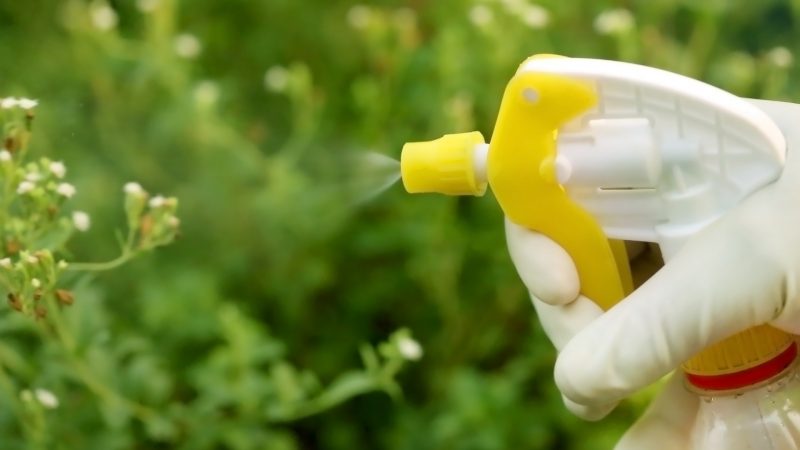
Before you decide what to use to get rid of your grasshoppers or locusts, you need to know the scale of your grasshopper infestation. How big or small the problem is will determine which method you choose.
Home Remedies To Get Rid of Grasshoppers and Locusts
The natural remedies for grasshoppers provided above should be enough for most people. You can get rid of grasshoppers naturally with garlic spray, diatomaceous earth, or other natural remedies for grasshoppers in your garden.
If you apply chemical insecticides or pesticides to your garden, make sure you read the instructions thoroughly. You may want to consult a pest control specialist.
List of Sources
Food and Agriculture Organization of the United Nations. Fighting the Locusts … Safely.
Merchant, M. (2012). How high can grasshoppers fly? Texas A&M AgriLife Extension.
Silezar, J. (2020). East Africa facing massive swarms of locusts. The Harvard Gazette.
Texas A&M AgriLife Extension. Grasshoppers and Their Control.
Evans, E. W., Hodgson, E. W. (2008). Grasshoppers. Utah State University Extension and Utah Plant Pest Diagnostic Laboratory.
- How to Get Rid of Cockroaches? | Proven Strategies & Solutions! - June 24, 2023
- Powerful Homemade Wasp and Bee Sprays (with Recipes) - March 4, 2023
- Crazy Ants Invasion | Eradicate & Prevent Unwanted Guests - February 24, 2023










